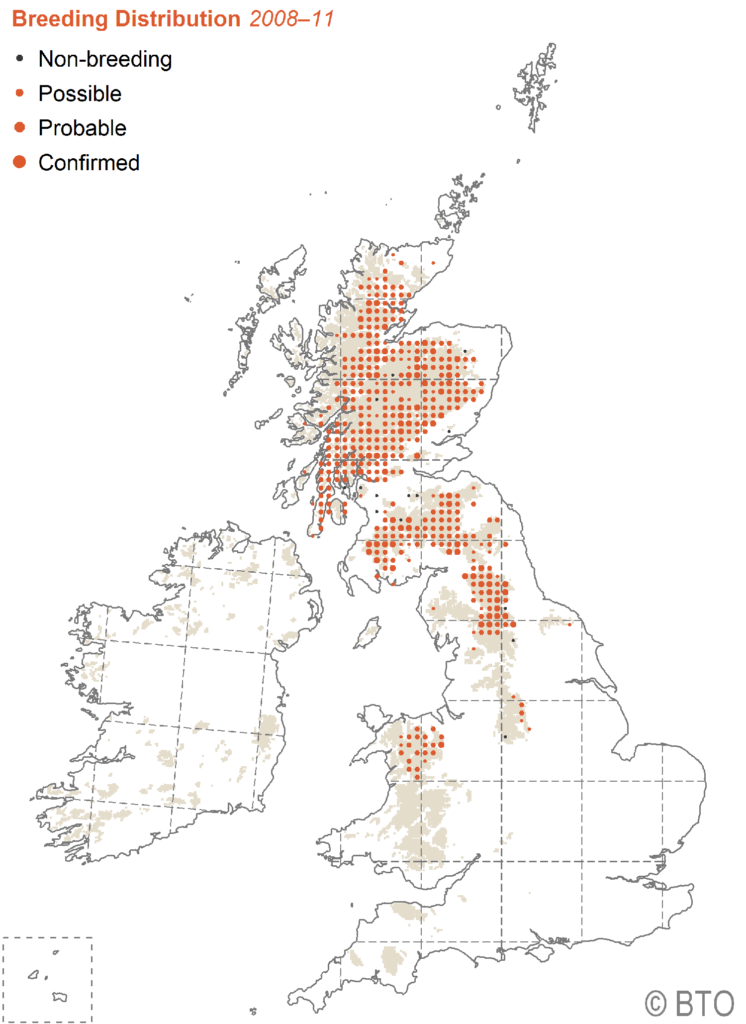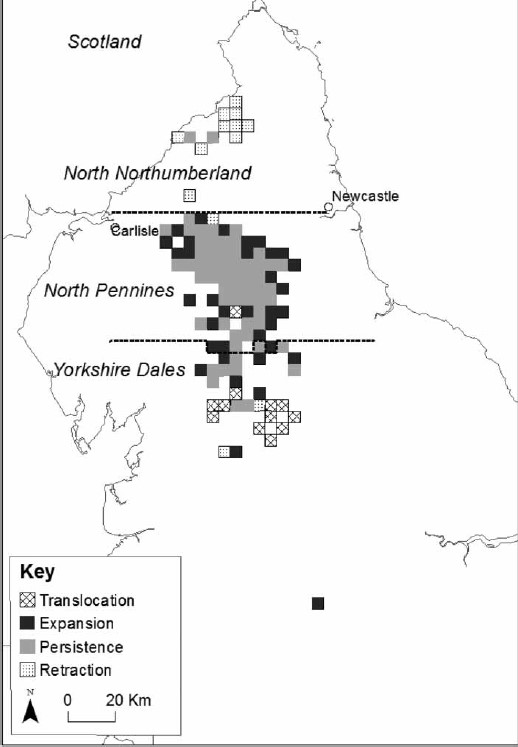Claim
Outside of Scotland, Lake Vrynwy, part of upland Wales, is one of the few places the endangered black grouse is found in the UK.
What the science says
True.
The black grouse is endangered and there are few places where they can be found. Outside of Scotland they are not limited just to upland Wales but are found across the uplands of England too. In England, they are now restricted to the North Pennines Area of Outstanding Beauty (AONB), Yorkshire Dales National Park and Nidderdale AONB.
Comes from
This statement was made on Countryfile on 22nd March 2020, where the episode featured the conservation work occurring at Lake Vyrnwy, Wales.
What the Science says – the fuller picture
Background
The black grouse is classified in the UK as Red under the Birds of Conservation Concern1. The last UK wide national survey was in 20052 and the population was estimated at 5,100 males, with 3,400 in Scotland, 1,500 in England and 200 in Wales. Black grouse in England were surveyed again in 2014, and 1,437 males were found3. The Avian Population Estimates Panel (APEP) published their latest report in February 2020, listing population estimates of birds in Great Britain and the UK4. In this report, numbers appear to have stabilised with an estimated 4,850 males in the UK from a bespoke calculation by one of the authors, N. Aebischer.
Range is the area a species is found in and is an important measurement. Reductions in range are often one of the first indicators of a species under pressure.
Leks are display sites used for breeding, found in open habitats such as moorland, farmland and forest clearings6. In their first year, young males typically join the local lek, however young females disperse to avoid inbreeding5.
Black grouse can be found in England, Wales and Scotland. In Scotland, they remain widespread across the country, whilst in England and Wales their range is now restricted, as shown in figure 1.
Distribution:

England
After the 1960s, black grouse became extinct in the southern counties of England, followed by widespread reductions in range between 1986 and 19912. A small population in North Staffordshire went extinct in 1997. By 1998, the last remaining black grouse in the Peak District were lost, restricting the English population to the North Pennines – from Wensleydale to the Scottish Borders.
The entire English population was surveyed in 1998 and only 773 males remained. Conservation schemes were implemented between 1998 and 2006 to increase numbers, which rose to 1,029 males5. However the range didn’t increase5. In 2014, another survey was conducted in England and numbers increased by 86% from 773 males in 1998 to 1,437 in 2014, with range increasing by 46%3 (figure 2).

There has been a fluctuation in numbers since 2006 because of multiple factors including poor breeding in 2007 and 20083 and a severe winter in 2009/20103. However, a good breeding season in 2013 increased numbers, with an average of 4.4 chicks per hen3. Overall, populations in North Pennies and the Yorkshire Dales were larger and more robust to survive harsh winters and poor breeding seasons but the North Northumberland population was too small to recover3.
Scotland
In 2005, surveys of black grouse showed a non-significant decline of 29% since 1995/96 in Scotland2. There were declines across the whole of Scotland, with large and significant declines in the southeast and southwest regions.
| Region | Percentage Decrease |
| Southwest | 49% |
| Southeast | 69% |
| North | 16% |
| Northeast | 9% |
Recent research has shown that numbers have continued to decline in southern Scotland, with the number of sample leks in the southwest falling from 70 males to zero and in the southeast, from 340 males to 44, (figure 3).6

Wales
In Wales, Black grouse are found in upland areas in north and mid-Wales10. Surveys showed a 39% increase from 1995/96 to 213 males in 20052. This increased to almost 320 recorded males in 20142, with Ruabon Mountain, near Wrexham, a stronghold where habitat management and predator control have been undertaken together.
Conservation:
To understand more about black grouse decline and conservation, please see the GWCT guide on conserving the black grouse. This is a practical guide produced for farmers, landowners and former Biodiversity Action Plan groups.
Plain English Summaries:
Plain English summaries of two of GWCT’s black grouse distribution and conservation papers can be found here:
The importance of moorland habitat for black grouse in southern Scotland
Increasing black grouse range by translocation
Donate and help us fight misinformation
References
- Eaton, M., Aebischer, N., Brown, A., Hearn, R., Lock, L., Musgrove, A., Noble, D., Stroud, D. & Gregory, R. (2015). Birds of Conservation Concern 4: The population status of birds in the UK, Channel Islands and Isle of Man. British Birds, 108:708–746.
- Sim, I.M.W., Eaton, M.A., Setchfield, R.P., Warren, P.K. & Lindley, P. (2008). Abundance of male Black Grouse Tetrao tetrix in Britain in 2005, and change since 1995-96. Bird Study, 55:304–313.
- Warren, P., Atterton, F., Baines, D., Viel, M., Deal, Z., Richardson, M. & Newborn, D. (2015). Numbers and distribution of Black Grouse Tetrao tetrix males in England: Results from the fourth survey in 2014. Bird Study, 62:202–207.
- Woodward, I., Aebischer, N., Burnell, D., Eaton, M., Frost, T., Hall, C., Stroud, D. & Noble, D. (2020). Population estimates of birds in Great Britain and the United Kingdom. British Birds, 106:64–100.
- Warren, P., Atterton, F., Anderle, M. & Baines, D. (2017). Expanding the range of black grouse Tetrao tetrix in northern England through translocating wild males. Wildlife Biology, 2017:wlb.00242.
- Warren, P., Land, C., Hesford, N. & Baines, D. (2019). Conserving Black Grouse Lyrurus tetrix in southern Scotland: evidence for the need to retain large contiguous moorland habitat within a forest-moorland landscape. Bird Study, 66:494–502.
- Warren, P. & Baines, D. (2004). Black Grouse in northern England: Stemming the decline. British Birds, 97:183–189.
- British Trust for Ornithology. (2013). Black grouse distribution across the UK. Bird Atlas:
- Pearce-Higgins, J.W., Wright, L.J., Grant, M.C. & Douglas, D.J.T. (2016). The role of habitat change in driving Black Grouse Tetrao tetrix population declines across Scotland. Bird Study, 63:66–72.
- Bowker, G., Bowker, C. & Baines, D. (2007). Survival Rates and Causes of Mortality in Black Grouse Tetrao Tetrix at Lake Vyrnwy, North Wales, UK. Wildlife Biology, 13:231–237.
- Geary, M., Fielding, A.H. & Marsden, S.J. (2015). Both habitat change and local lek structure influence patterns of spatial loss and recovery in a black grouse population. Population Ecology, 57:421–431.
- Scridel, D., Groom, J.D. & Douglas, D.J.T. (2017). Native woodland creation is associated with increase in a Black Grouse Lyrurus tetrix population. Bird Study, 64:70–83.
- Jahren, T., Storaas, T., Willebrand, T., Fossland Moa, P. & Hagen, B.R. (2016). Declining reproductive output in capercaillie and black grouse-16 countries and 80 years. Animal Biology, 66:363–400.
- Signorell, N., Wirthner, S., Patthey, P., Schranz, R., Rotelli, L. & Arlettaz, R. (2010). Concealment from predators drives foraging habitat selection in brood-rearing Alpine black grouse Tetrao tetrix hens: habitat management implications. Wildlife Biology, 16:249–257.